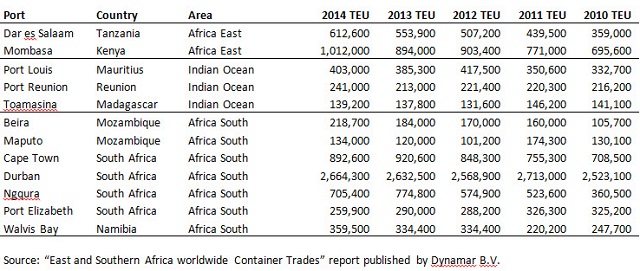East and Southern Africa in Development Boom
In the minds of many, the container trade between east and southern Africa forms an altogether insignificant trade. That may be true if comparing it with a high volume area such as the Far East. Yet this region’s combined port throughput is approaching eight million TEUs, which is technically more than the whole of the Australian continent, and there is so much scope for growth in the 23 countries with their 437 million inhabitants.
Dynamar has recently issued its latest report in its Container Markets and Trades series: East & Southern Africa (worldwide) Container Trades. The report highlights that:
• East and southern Africa’s container volumes have grown by nine percent compound annual growth rate (CAGR) since 2010
• China’s exports to East Africa is expected to increase by 91 percent by 2020
• The area is experiencing strong growth, rising incomes, falling poverty and economic diversification
• Transit cargo from Mombasa is growing at an average of seven percent; current share is 30 percent
• Inland transportation costs are reaching 77 percent of export value
• Sub Saharan Africa’s largest port is Durban, South Africa
• Somali-attributed pirate attacks back from 2010’s 220 to ten (too many) in 2014
The three main African regions covered in the report consist of 23 countries:
East Africa: coastal Somalia, Kenya and Tanzania, plus seven landlocked countries
Indian Ocean: Madagascar, Mauritius, La Réunion (France) and three more island states
Southern Africa: littoral Mozambique, South Africa and Namibia, plus four non-coastal nations
Dirk Visser, Senior Shipping Consultant and Managing Editor DynaLiners, says: “Imagine that the East and Southern Africa container trades would catch up, relatively, and in one year’s time, with that of the U.S. with its population of 323 million. In that case, the relevant African TEU volume would grow to 42 million TEUs, up 1,200 percent from the 3.2 million TEUs of 2014. A period of 25 years may be more realistic. This would then translate into a compound annual growth rate (CAGR) of nearly 11 percent.
“Exaggerated? A bit perhaps, but combined, east and southern Africa including the Indian Ocean Islands have seen full container volumes growing by a CAGR of over nine percent since 2010. This backed up by the value of their merchandise trade expanding by more than 26 percent to $385 billion over the same period.”
Littorals and megalomaniac terminal projects
Although three carriers, CMA CGM, MSC and Simatech are nowadays serving Mogadishu, but Somalia, including Somaliland and Puntland, is still largely defunct, says Visser. “Hence, East Africa currently counts just two active littoral countries: Kenya and Tanzania. These serve a more than seven-country hinterland, comprising a population of well over 200 million souls, more than double their own. Altogether, an indication of the increasing pressure on their ports to serve such an extensive and economically growing inland area via often physically inadequate connections larded with numerous checkpoints, if not roadblocks.”
Mombasa, Kenya, expecting its current 1.0 million TEUs throughput to double by 2020, is building a new 1.2 million TEU container terminal, after recently having expanded its existing one.
Contender for various inland destinations, Dar-es-Salaam, Tanzania, has longstanding plans and a long shortlist of no less than ten companies to build a new, 600,000 TEUs box facility, doubling present capacity. In addition, some multipurpose berths will be strengthened to handle containers.
In addition to their main ports, both countries are ushering in their smaller secondary outlets. The main ones are Lamu in Kenya and Bagamoyo and Mwambani in Tanzania. These have in common that they are to become the oceanic starting points of transport corridors of sometimes megalomaniac, multi-billion dimensions as they are to include port facilities, roads, railways, pipelines and warehouses.
Bagamoyo, opposite Zanzibar and 75-kilometre north of Dar-es-Salaam, was the capital of former German East Africa. Visser says that China Merchants (Holding) International and Oman have jointly funded $11 billion to build a 20 million TEU capacity container port there. However, it is still not excluded that preference will be given to the southern port of Mtwara, near the border with Mozambique.
The Indian Ocean Islands comprise some of the smallest territories, think of the French Département d'Outre-Mer Mayotte with its 376 square kilometers, says Visser. “By contrast, Madagascar is the world’s largest single island nation (582,000 square kilometers), boasting at least 13 sea ports. The government of Mauritius aims at transforming the island into a high-income country by 2025. Hence, Mauritius Container Terminal at Port Louis is being expanded to accommodate the expected 1.0 million TEU container throughput by then, around double the present volume of which 55 percent is transhipment.”
Southern and South
Various of the (all private) ports in Mozambique, including Beira, Maputo and Nacala, are competing for connections with landlocked Zambia, Zimbabwe and Malawi, and with South Africa’s heavy industrialized Gauteng accommodating the capital of Johannesburg in particular. Rich in natural resources and a potential supplier of LNG, amongst others, Mozambique’s economy is doing well.
South Africa is the largest of the only three littoral southern African countries and the single African G-20 member. Durban, its main outlet, is the largest of the only four Sub-Saharan African millionaires by container throughput. The building of a new, 9.6 million TEU capacity port at the site of the former airport has been continuously delayed but is now to start by 2021. Like all South African ports, it will be operated by parastatal Transnet.
In a remarkable second week of December last year, the South African government had three finance ministers at a row, says Visser. “If this 55-million people country’s outlook remains weak (2.5 percent average until 2020), it is mainly due to severe domestic challenges.”
Table
Five-year throughput of east and southern African ports handling minimum 100,000 TEUs

